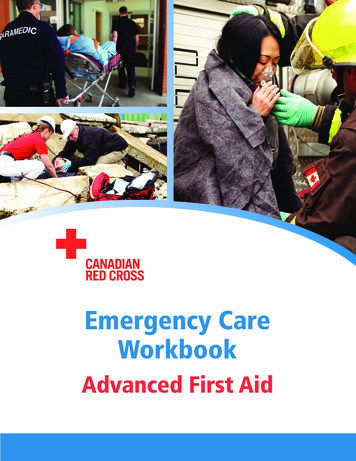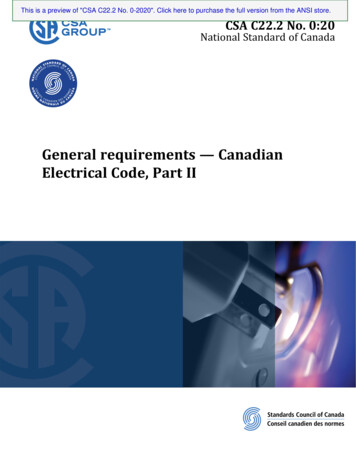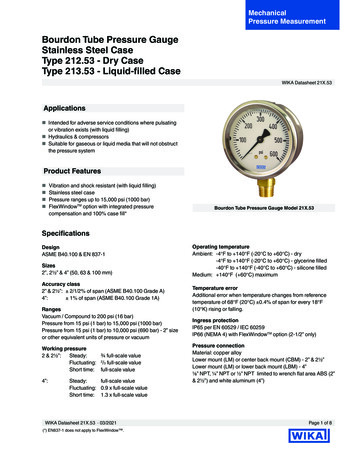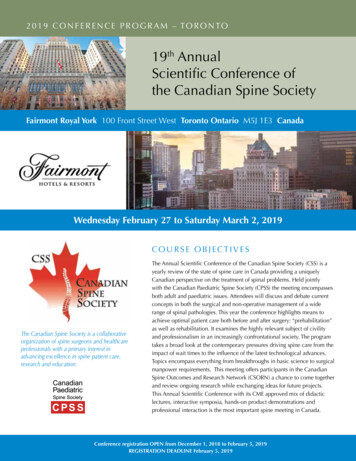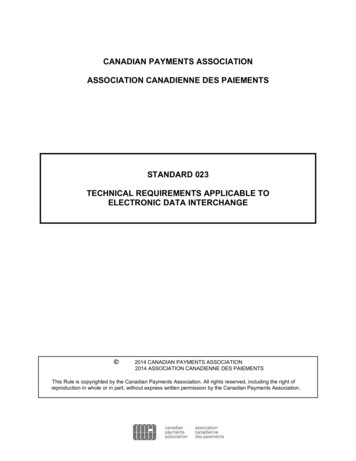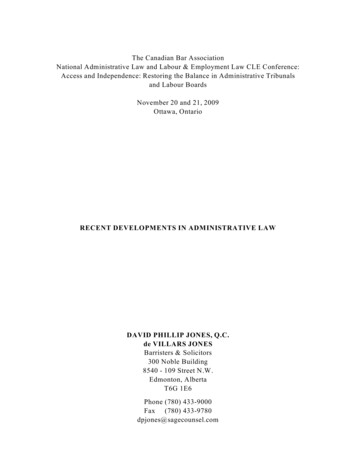
Transcription
The Canadian Bar AssociationNational Administrative Law and Labour & Employment Law CLE Conference:Access and Independence: Restoring the Balance in Administrative Tribunalsand Labour BoardsNovember 20 and 21, 2009Ottawa, OntarioRECENT DEVELOPMENTS IN ADMINISTRATIVE LAWDAVID PHILLIP JONES, Q.C.de VILLARS JONESBarristers & Solicitors300 Noble Building8540 - 109 Street N.W.Edmonton, AlbertaT6G 1E6Phone (780) 433-9000Fax (780) 433-9780dpjones@sagecounsel.com
TABLE OF CONTENTSI.INTRODUCTION. . . . . . . . . . . . . . . . . . . . . . . . . . . . . . . . . . . . . . . . . . . . . . . . . 1II.STANDARDS OF REVIEW. . . . . . . . . . . . . . . . . . . . . . . . . . . . . . . . . . . . . . . . . 2A.The Aftermath of Dunsmuir. . . . . . . . . . . . . . . . . . . . . . . . . . . . . . . . . . . . . 21.2.3.4.5.III.Statutory Standards of Review: Khosa, Manz and others. . . . . . . . . 3The meaning of reasonableness. . . . . . . . . . . . . . . . . . . . . . . . . . . . 15Questions of Law: Khosa and Western Forest Products Inc. . . . . 21Proper Application of the Standard. . . . . . . . . . . . . . . . . . . . . . . . . 28Other interesting post-Dunsmuir cases. . . . . . . . . . . . . . . . . . . . . . 33B.Standards of Review and Questions of Procedural Fairness. . . . . . . . . . . . 37C.Standards of Review and Administrative Appellate Tribunals. . . . . . . . . . 43THE DUTY TO BE FAIR. . . . . . . . . . . . . . . . . . . . . . . . . . . . . . . . . . . . . . . . . . 44A.The Duty of Fairness in the Investigative Stage. . . . . . . . . . . . . . . . . . . . . 451.2.Hills v. Provincial Dental Board of Nova Scotia. . . . . . . . . . . . . . . 45Lienaux v. Nova Scotia Barristers’ Society. . . . . . . . . . . . . . . . . . . 46B.No Duty to Provide a Transcript. . . . . . . . . . . . . . . . . . . . . . . . . . . . . . . . . 46C.The Duty to Give Reasons. . . . . . . . . . . . . . . . . . . . . . . . . . . . . . . . . . . . . . 501.2.3.4.Hills v. Provincial Dental Board of Nova Scotia. . . . . . . . . . . . . . .Clifford v. Ontario Municipal Employees’ Retirement System. . . .MacDonald v. Mineral Springs Hospital. . . . . . . . . . . . . . . . . . . . .BC’s Administrative Justice Office Discussion Paper onReasons. . . . . . . . . . . . . . . . . . . . . . . . . . . . . . . . . . . . . . . . . . . . . . .50515253D.The Duty to Disclose. . . . . . . . . . . . . . . . . . . . . . . . . . . . . . . . . . . . . . . . . . 54E.Evidentiary Issues. . . . . . . . . . . . . . . . . . . . . . . . . . . . . . . . . . . . . . . . . . . . 551.2.Deemar v. College of Veterinarians of Ontario. . . . . . . . . . . . . . . . 55Wasylyshen v. Alberta (Law Enforcement Review Board). . . . . . . . 55-i-
F.The Right to Self-Representation. . . . . . . . . . . . . . . . . . . . . . . . . . . . . . . . 56G.The Rule Against Bias. . . . . . . . . . . . . . . . . . . . . . . . . . . . . . . . . . . . . . . . . 571.2.3.4.5.6.7.IV.V.Pelletier and Chrétien. . . . . . . . . . . . . . . . . . . . . . . . . . . . . . . . . . .Beier v. Vermilion River (County). . . . . . . . . . . . . . . . . . . . . . . . . .Gahir v. Alberta (Workers’ Compensation AppealsCommission). . . . . . . . . . . . . . . . . . . . . . . . . . . . . . . . . . . . . . . . . . .Fundy Linen Service Inc. v. New Brunswick (Workplace Health,Safety and Compensation Commission). . . . . . . . . . . . . . . . . . . . . .Asquini v. British Columbia (Workers’ Compensation AppealTribunal). . . . . . . . . . . . . . . . . . . . . . . . . . . . . . . . . . . . . . . . . . . . . .Waste Management of Canada Corp. v. ThorhildNo. 7 (County). . . . . . . . . . . . . . . . . . . . . . . . . . . . . . . . . . . . . . . . .Boardwalk Reit LLP v. Edmonton (City). . . . . . . . . . . . . . . . . . . . .57616363686969STANDING. . . . . . . . . . . . . . . . . . . . . . . . . . . . . . . . . . . . . . . . . . . . . . . . . . . . . . 70A.Buttar v. Workers’ Compensation Appeal Tribunal. . . . . . . . . . . . . . . . . . 71B.Bargen v. Northwest Territories (Medical Board of Inquiry). . . . . . . . . . . 73C.Beier v. Vermilion River (County). . . . . . . . . . . . . . . . . . . . . . . . . . . . . . . . 74D.Commission des transports du Québec c Villeneuve et TribunalAdministratif du Québec. . . . . . . . . . . . . . . . . . . . . . . . . . . . . . . . . . . . . . . 75MULTIPLE FORUMS—CONCURRENT, EXCLUSIVE,SEQUENTIAL. . . . . . . . . . . . . . . . . . . . . . . . . . . . . . . . . . . . . . . . . . . . . . . . . . . 75A.Is judicial review a pre-condition for suing the Federal Crown?. . . . . . . . 771.2.3.4.B.The TeleZone case. . . . . . . . . . . . . . . . . . . . . . . . . . . . . . . . . . . . . .G-Civil Inc. v. Canada. . . . . . . . . . . . . . . . . . . . . . . . . . . . . . . . . . .Fielding Chemical Technologies Inc. v. Canada. . . . . . . . . . . . . . .McArthur v. Canada. . . . . . . . . . . . . . . . . . . . . . . . . . . . . . . . . . . . .79798080Federal Court or Provincial Superior Court? State Farm MutualAutomobile Insurance Co. v. Canada (Privacy Commissioner). . . . . . . . . 85-ii-
C.VI.VII.Proper Forum—Different Administrative Tribunals: University ofSaskatchewan v. Workers’ Compensation Board of Saskatchewan. . . . . . 86DISCLOSURE AND PRIVACY. . . . . . . . . . . . . . . . . . . . . . . . . . . . . . . . . . . . . 88A.Law Society of Saskatchewan v. E.F.A. Merchant, Q.C. . . . . . . . . . . . . . . 88B.Alberta Union of Provincial Employees v. United Nurses of Alberta,Local 168. . . . . . . . . . . . . . . . . . . . . . . . . . . . . . . . . . . . . . . . . . . . . . . . . . . 90A MISCELLANY OF OTHER DEVELOPMENTS. . . . . . . . . . . . . . . . . . . . . 93A.Alberta (Minister of Employment and Immigration) v. AlbertaFederation of Labour. . . . . . . . . . . . . . . . . . . . . . . . . . . . . . . . . . . . . . . . . 93B.Democracy Watch v. Conflict of Interest and EthicsCommissioner and Attorney General of Canada. . . . . . . . . . . . . . . . . . . . 94C.Stetler v. Ontario Flue-Cured Tobacco Growers’ Marketing Board. . . . . 94D.Walsh v. Mobil Oil Canada. . . . . . . . . . . . . . . . . . . . . . . . . . . . . . . . . . . . . 95E.Confédération des syndicats nationaux v. Canada (Attorney General). . . 95F.The Record. . . . . . . . . . . . . . . . . . . . . . . . . . . . . . . . . . . . . . . . . . . . . . . . . 96G.Using the Bill of Rights to ensure a fair hearing process. . . . . . . . . . . . . . 98H.Alberta’s Bill 32. . . . . . . . . . . . . . . . . . . . . . . . . . . . . . . . . . . . . . . . . . . . . 98I.The Demise of the B.C. Administrative Justice Office. . . . . . . . . . . . . . . . 99VIII. CONCLUSION. . . . . . . . . . . . . . . . . . . . . . . . . . . . . . . . . . . . . . . . . . . . . . . . . . . 99-iii-
CBA National Administrative andLabour & Employment Law CLENovember 2009I.INTRODUCTIONLike in previous years, this paper1 highlights significant developments in administrative lawover the past year. Decisions of the Supreme Court of Canada, provincial appeal courts andother noteworthy judicial and legislative trends will be identified in an attempt to give abroad overview of the ever-developing principles of administrative law.In 2008, the Supreme Court of Canada attempted to simplify the standards-of-review analysisin Dunsmuir. Not surprisingly, the aftermath of Dunsmuir has been both interesting andwidespread. Courts have been interpreting and applying Dunsmuir in a vast array ofadministrative law decisions. Unfortunately, not all courts have gotten it right and it hasbecome apparent that some areas of the standards-of-review analysis are still unclear andmisunderstood. A good deal of this year’s paper will focus on the aftermath of Dunsmuir andthe areas that still require clarification.Of course, there also have been interesting cases dealing with all aspects of the duty to befair, multiple forums, privacy and disclosure, and the usual multitude of interestingadministrative law cases that do not fit neatly into the categories above.1.I gratefully acknowledge the very capable assistance of Dawn M. Knowles, LL.B. from our officein the preparation of this paper. I also appreciate those from across the country who draw myattention to interesting developments in administrative law in their jurisdictions.
2II.STANDARDS OF REVIEWA.The Aftermath of DunsmuirCBA National Administrative andLabour & Employment Law CLENovember 2009The previous two papers began their discussion of standards of review by citing a 2007comment of Justice Berger of the Court of Appeal of Alberta in which he describes thestandard-of-review maze as perplexing, tortuous and exhausting.2In 2008, the Supreme Court of Canada appeared to heed those comments. The court inDunsmuir attempted to simplify standards-of-review analysis by merging the two deferentialstandards of review into a new unified standard of reasonableness,3 and streamlining theanalysis where precedent has already determined the standard of review applicable to aparticular decision.However, almost exactly one year later, the Supreme Court of Canada’s decision in Canada(Minister of Citizenship & Immigration) v. Khosa 4 once again raises a number of interestingquestions, at least with respect to how the new standards-of-review analysis will be appliedwhere there is a statutory standard of review.2.Chauvet v. Alberta (Workers’ Compensation Board, Appeals Commission), 2007 ABCA 155 atparagraph 17. Justice Berger’s comments are reminiscent of Justice LeBel’s cri de coeur inToronto v. C.U.P.E., [2003] 3 S.C.R. 3, 232 D.L.R. (4th) 385.3.Not “patent unreasonableness”, as was the case pre-Southam.4.2009 SCC 12.
31.CBA National Administrative andLabour & Employment Law CLENovember 2009Statutory Standards of Review: Khosa, Manz and others(a)Canada (Minister of Citizenship & Immigration) v. KhosaKhosa dealt with a removal order under the Immigration and Refugee Protection Act.5 TheImmigration and Refugee Board had ordered Khosa to return to India following a convictionfor criminal negligence causing death in an automobile street race. The Immigration AppealDivision upheld the decision and did not accept that there were humanitarian andcompassionate grounds to warrant special relief.Khosa applied to the Federal Court for judicial review. The judicial review judge dismissedthe application on the grounds that it was not patently unreasonable.6 Khosa appealed to theFederal Court of Appeal.After applying the four Pushpanathan factors, the majority of the Federal Court of Appeal7reversed the Federal Court’s decision and held that the standard of review should have beenreasonableness simpliciter, not patent unreasonableness,8 and quashed the Board’s decisionas being unreasonable. The Minister appealed the decision to the Supreme Court of Canada.The Minister argued that section 18.1 of the Federal Court Act establishes a legislatedstandard of review that displaces the common law. In other words, the Minister argued thata pragmatic and functional analysis is not required where a statutory standard of review is5.S.C. 2001, c. 27.6.2005 FC 1218.7.2007 FCA 24.8.Both of these lower court decisions were decided before Dunsmuir was decided.
4CBA National Administrative andLabour & Employment Law CLENovember 2009set out9 and, therefore, the analysis in Dunsmuir, which by then had been decided, isaltogether irrelevant in such cases.Eight of the nine judges allowed the Minister’s appeal and restored the decision of theImmigration Appeal Division.However, although they agreed in the outcome, theydisagreed on the approach to be used.(i)The application of Dunsmuir where the legislature has specified theapplicable standard of review 10Writing for the largest group in the majority,11 Justice Binnie first notes that the decision inDunsmuir has changed the focus in judicial review applications:4 Dunsmuir teaches that judicial review should be less concerned with the formulation ofdifferent standards of review and more focussed on substance, particularly on the nature ofthe issue that was before the administrative tribunal under review. Here, the decision of theIAD required the application of broad policy considerations to the facts as found to berelevant, and weighed for importance, by the IAD itself. The question whether Khosa hadshown “sufficient humanitarian and compassionate considerations? to warrant relief fromhis removal order, which all parties acknowledged to be valid, was a decision whichParliament confided to the IAD, not to the courts. I conclude that on general principles ofadministrative law, including our Court’s recent decision in Dunsmuir, the applicationsjudge was right to give a higher degree of deference to the IAD decision than seemedappropriate to the Federal Court of Appeal majority. In my view, the majority decision ofthe IAD was within a range of reasonable outcomes and the majority of the Federal Courtof Appeal erred in intervening in this case to quash it. The appeal is therefore allowed andthe decision of the Immigration Appeal Division is restored.9.It was argued that s. 18.1(4) of the Federal Courts Act, R.S.C. 1985, c. F-7, sets out the standardof review to be used, not just the grounds for review.10.This portion of the paper is taken largely from my annotation which was published in theAdministrative Law Reports at (2009) 82 Admin. L.R. (4th) 123.11.Chief Justice McLachlin and Justices Binnie, LeBel, Abella and Charron.
5CBA National Administrative andLabour & Employment Law CLENovember 2009Justice Binnie goes on to discuss the importance of considering the role of Parliament andthe legislatures in judicial review applications, particularly in the area of standard of review.He accepts that the legislature may validly specify the standard of review (subject to certainconstitutional limitations); and, if this is done, then the courts’ duty is to apply the specifiedstandard of review:1217 This appeal provides a good illustration of why the adjustment made by Dunsmuir wastimely. By switching the standard of review from patent unreasonableness to reasonablenesssimpliciter, the Federal Court of Appeal majority felt empowered to retry the case inimportant respects, even though the issues to be resolved had to do with immigration policy,not law. Clearly, the majority felt that the IAD disposition was unjust to Khosa. However,Parliament saw fit to confide that particular decision to the IAD, not to the judges.18 In cases where the legislature has enacted judicial review legislation, an analysis of thatlegislation is the first order of business. Our Court had earlier affirmed that, withinconstitutional limits, Parliament may by legislation specify a particular standard of review:see R. v. Owen, 2003 SCC 33, [2003] 1 S.C.R. 779. Nevertheless, the intended scope ofjudicial review legislation is to be interpreted in accordance with the usual rule that theterms of a statute are to be read purposefully in light of its text, context and objectives.19 Generally speaking, most if not all judicial review statutes are drafted against thebackground of the common law of judicial review. Even the more comprehensive amongthem, such as the British Columbia Administrative Tribunals Act, S.B.C. 2004, c. 45, canonly sensibly be interpreted in the common law context because, for example, it providesin s. 58(2)(a) that “a finding of fact or law or an exercise of discretion by the tribunal inrespect of a matter over which it has exclusive jurisdiction under a privative clause must notbe interfered with unless it is patently unreasonable”. The expression “patentlyunreasonable” did not spring unassisted from the mind of the legislator. It was obviouslyintended to be understood in the context of the common law jurisprudence, although anumber of indicia of patent unreasonableness are given in s. 58(3). Despite Dunsmuir,“patent unreasonableness” will live on in British Columbia, but the content of theexpression, and the precise degree of deference it commands in the diverse circumstancesof a large provincial administration, will necessarily continue to be calibrated according togeneral principles of administrative law. That said, of course, the legislature in s. 58 wasand is directing the B.C. courts to afford administrators a high degree of deference on issuesof fact, and effect must be given to this clearly expressed legislative intention.1312.At paras. 17 to 19.13.Of course, as occurred in Khosa itself, there may be an issue about whether the legislature hasclearly specified a standard of review, or has intended to displace general administrative law.
6CBA National Administrative andLabour & Employment Law CLENovember 2009[Emphasis added.]Therefore, the “patently unreasonable” standard continues in jurisdictions like BritishColumbia with statutorily codified standards of review, notwithstanding that Dunsmuirmerged the two deferential standards into one standard called reasonableness. However,according to the majority in Khosa, the precise content of patent unreasonableness will varyaccording to the circumstances of the case and “the ordinary principles of administrativelaw”.14 What is not clear is how “the ordinary principles of administrative law” will continueto have anything to say about the content of the patent unreasonableness standard.It was then necessary for the Court to determine whether section 18.1 of the Federal CourtsAct contains a statutorily codified standard of review which the court was bound to apply onthis appeal.(ii)Whether section 18.1 of the Federal Courts Act sets out grounds for review,or standards of reviewThe majority in Khosa were divided on this issue.Justice Binnie held that section 18.1 of the Federal Courts Act sets out grounds for judicialreview, not standards of review. Accordingly, the standard of review applicable to each14.When Justice Binnie speaks about “calibrating” patent unreasonableness in the B.C. ATA“according to general principles of administrative law”, does “calibrating” imply that “patentunreasonableness” has a variable meaning, or is a spectrum? Or is this comment merely intendedto mirror the situation with the new “reasonableness” standard, whose meaning is context-driven?Also, is the meaning of “patent unreasonableness” now effectively frozen? How would it bepossible to continue to develop after Dunsmuir (which merged it into the new reasonablenessstandard)?
7CBA National Administrative andLabour & Employment Law CLENovember 2009particular ground must be determined for each situation, using the standards-of-reviewanalysis from Dunsmuir:1528 In my view, the interpretation of s. 18.1 of the Federal Courts Act must be sufficientlyelastic to apply to the decisions of hundreds of different “types” of administrators, fromCabinet members to entry-level fonctionnaires, who operate in different decision-makingenvironments under different statutes with distinct grants of decision-making powers. Someof these statutory grants have privative clauses; others do not. Some provide for a statutoryright of appeal to the courts; others do not. It cannot have been Parliament’s intent to createby s. 18.1 of the Federal Courts Act a single, rigid Procrustean standard of decontextualizedreview for all “federal board[s], commission[s] or other tribunal[s]”, an expression whichis defined (in s. 2) to include generally all federal administrative decision makers. Aflexible and contextual approach to s. 18.1 obviates the need for Parliament to setcustomized standards of review for each and every federal decision maker.Justice Binnie considered both the English and French versions of section 18 and concludedthat section 18.1(4) is not intended to operate as a self-contained code, but is intended byParliament to be interpreted and applied against the backdrop of the common law, includingthose elements most recently expounded in Dunsmuir. He further stated [footnotes deleted]:50 I readily accept, of course, that the legislature can by clear and explicit language oust thecommon law in this as in other matters. Many provinces and territories have enactedjudicial review legislation which not only provide guidance to the courts but have the addedbenefit of making the law more understandable and accessible to interested members of thepublic. The diversity of such laws makes generalization difficult. In some jurisdictions (asin British Columbia), the legislature has moved closer to a form of codification than hasParliament in the Federal Courts Act. Most jurisdictions in Canada seem to favour alegislative approach that explicitly identifies the grounds for review but not the standard ofreview. In other provinces, some laws specify “patent unreasonableness”. In few of thesestatutes, however, is the content of the specified standard of review defined, leading to theinference that the legislatures left the content to be supplied by the common law.51 As stated at the outset, a legislature has the power to specify a standard of review, asheld in Owen, if it manifests a clear intention to do so. However, where the legislativelanguage permits, the courts (a) will not interpret grounds of review as standards of review,(b) will apply Dunsmuir principles to determine the appropriate approach to judicial reviewin a particular situation, and (c) will presume the existence of a discretion to grant or15.At para. 28.
8CBA National Administrative andLabour & Employment Law CLENovember 2009withhold relief based on the Dunsmuir teaching of restraint in judicial intervention inadministrative matters (as well as other factors such as an applicant’s delay, failure toexhaust adequate alternate remedies, mootness, prematurity, bad faith and so forth).[Emphasis added.]Although they concurred in the result, Justices Rothstein and Deschamps disagreed withJustice Binnie’s interpretation of section 18.1.16 In their view, section 18.1 expresslyprovides for the standard of review, and the court should not superimpose a duplicativecommon law analysis.17 As Justice Rothstein noted, given this interpretation, the Dunsmuiranalysis is irrelevant:72 The language of s. 18.1(4)(d) makes clear that findings of fact are to be reviewed on ahighly deferential standard. Courts are only to interfere with a decision based on erroneousfindings of fact where the federal board, commission or other tribunal’s factual finding was“made in a perverse or capricious manner or without regard for the material before it”. Bycontrast with para. (d), there is no suggestion that courts should defer in reviewing aquestion that raises any of the other criteria in s. 18.1(4). Where Parliament intended adeferential standard of review in s. 18.1(4), it used clear and unambiguous language. Thenecessary implication is that where Parliament did not provide for a deferential standard, itsintent was that no deference be shown. As I will explain, the language and context ofs. 18.1(4), and in particular the absence of deferential wording, demonstrates that acorrectness standard is to be applied to questions of jurisdiction, natural justice, law andfraud. The language of s. 18.1(4)(d) indicates that deference is only to be applied toquestions of fact.73 Dunsmuir reaffirmed that “determining the applicable standard of review isaccomplished by establishing legislative intent” (para. 30). The present majority’sinsistence that Dunsmuir applies even where Parliament specifies a standard of review isinconsistent with that search for legislative intent, in my respectful view.Therefore, while Justice Binnie and Justice Rothstein both agree that the Dunsmuir standardof-review analysis is not necessary where there is a statutory standard of review, they16.Justice Deschamps agreed with Justice Rothstein that section 18.1(4) of the Federal Courts Actsets legislated standards of review, which oust the common law.17.At para. 70.
9CBA National Administrative andLabour & Employment Law CLENovember 2009disagree about the proper interpretation and function of section 18.1(4) of the Federal CourtsAct. Justice Binnie concludes that section 18.1 only sets out grounds of review, so thatDunsmuir must be used to determine the applicable standard of review (which in this casewas reasonableness). It concludes that the Immigration Appeal Division decision wasreasonable and ought to be restored. On the other hand, Justices Rothstein and Abellaconcluded that section 18.1 sets out the standard of review (which, given the wording, washighly deferential). According to Justice Rothstein, because the factual findings of theImmigration Appeal Division were not perverse or capricious or made without regard to theevidence, its decision should not have been quashed.(iii)The differing perspectivesOn the issue of whether section 18.1 establishes a standard of review, Justice Binnie viewsthe issue as a matter of statutory interpretation and addresses the different approach taken byJustice Rothstein as follows:35 My colleague Rothstein J. writes that “to say (or imply) that a Dunsmuir standard ofreview analysis applies even where the legislature has articulated the applicable standardof review directly contradicts Owen” (para. 100). This assumes the point in issue, namelywhether as a matter of interpretation, Parliament has or has not articulated the applicablestandard of review in s. 18.1.36 In my view, the language of s. 18.1 generally sets out threshold grounds which permitbut do not require the court to grant relief. Whether or not the court should exercise itsdiscretion in favour of the application will depend on the court’s appreciation of therespective roles of the courts and the administration as well as the “circumstances of eachcase”: see Harelkin v. University of Regina, [1979] 2 S.C.R. 561, at p. 575. Further, “[i]none sense, whenever the court exercises its discretion to deny relief, balance of convenienceconsiderations are involved” (D. J. M. Brown and J. M. Evans, Judicial Review ofAdministrative Action in Canada (loose-leaf), at p. 3-99). Of course, the discretion must beexercised judicially, but the general principles of judicial review dealt with in Dunsmuirprovide elements of the appropriate judicial basis for its exercise.37 On this point, as well, my colleague Rothstein J. expresses disagreement. He cites anumber of decisions dealing with different applications of the Court’s discretion. He draws
10CBA National Administrative andLabour & Employment Law CLENovember 2009from these cases the negative inference that other applications of the discretion are excludedfrom s. 18.1(4). In my view, with respect, such a negative inference is not warranted.There is indeed a fundamental disagreement on the Court about the proper conceptualframework for standards-of-review analysis. The question is: who is right, and how will itdevelop in the future?(iv)The relationship between determining the standard of review and the court’sinherent discretion always to refuse a remedyAlthough Justice Binnie clearly recognizes the existence of a discretion to grant or withholdrelief due to delay, failure to exhaust adequate alternate remedies, mootness, prematurity, badfaith and so forth, it appears that he conceives that the Dunsmuir teaching of restraint injudicial intervention in administrative matters is also discretionary.18By contrast, Justice Rothstein makes the important distinction between deference under thereasonableness standard of review (which is not discretionary) and the court’s inherentdiscretion always to refuse a remedy (regardless of the standard of review). The discretionto refuse to grant a remedy does not engage the question of standard of review.19In my view, Justice Rothstein is right on this point.18.At paras. 36, 42, 51.19.At paras. 134 to 136.
11(v)CBA National Administrative andLabour & Employment Law CLENovember 2009Summary on KhosaKhosa undoubtedly establishes that the legislature can specify a standard of review which isdifferent from those contained in Dunsmuir.20 There will always be an issue about whetherthe legislature has clearly done this.To the extent that the legislature has not clearly specified the standard of review so thatDunsmuir does apply, there is a fundamental difference between Justice Binnie and JusticeRothstein in Khosa about how one determines whether and when the court is to defer to thestatutory decision-maker. In particular, there is a difference about whether privative clausesare the mechanism by which the legislature signals its intent, or whether “expertise”(however that is defined) provides an additional “stand alone” basis for deference. There isalso a significant division about the circumstances in which the courts should defer onquestions of law, as well as whether judicial review and appellate review are fundamentallythe same or different.In my view, the judgments in Khosa demonstrate a lamentable lack of common ground aboutthe fundamental concepts of administrative law, including the proper role of the courts insupervising the executive. Looking back over the past thirty years or so, this lack ofconceptual commonality may explain why the Supreme Court’s administrative law decisionshave so many dissents, and why the rationale of the cases seems to zig and zag.(b)Manz v. British Columbia (Workers’ Compensation Appeal Tribunal)The impact of Dunsmuir in jurisdictions with statutory standards of review was alsoaddressed by the British Columbia Court of Appeal in Manz v. British Columbia (Workers’20.Subject to some constitutional limitations that would prevent all forms of judicial review.
12CBA National Administrative andLabour & Employment Law CLENovember 2009Compensation Appeal Tribunal).21 Manz was injured in a motorcycle accident while on hisway home from work but while still on his employer’s property.The Workers’Compensation Appeal Tribunal (“WCAT”) held that Manz’s injuries arose out of, and in thecourse of, his employment. Because the other driver, Sundher, was also acting
National Administrative Law and Labour & Employment Law CLE Conference: Access and Independence: Restoring the Balance in Administrative Tribunals and Labour Boards November 20 and 21, 2009 Ottawa, Ontario RECENT DEVELOPMENTS IN ADMINISTRATIVE LAW DAVID PHILLIP JONES, Q.C. de VILLARS JONE

